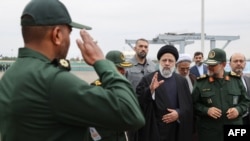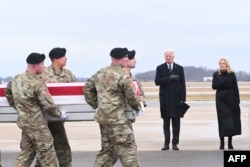The Iranian regime is pushing a propaganda narrative to misportray the security measures that the U.S. and U.K have implemented in response to attacks from Iran-backed forces in the Middle East as an act of aggression intended to expand the Israel-Hamas war.
At a weekly press conference on February 5, Iranian Foreign Minister Nasser Kanani called recent U.S. strikes against Iranian-backed militia groups in Iraq, Syria and Yemen a “clumsy attempt” to divert attention from events in the Gaza Strip.
“Instead of choosing peace in the region, the U.S. and the U.K. prefer to choose the Israeli regime and the interests of [prime minister Benjamin] Netanyahu over those of nations and governments. … Their behavior is inconsistent with their claims on non-expansion of the [Gaza] war in the region,” Kanani said.
“Attacking other countries is a violation of the national sovereignty of Syria, Iraq and Yemen and a clumsy attempt to divert public attention from the focal point of the crisis.”
That is false.
Iran has been backing upwards of 100 violent militia groups across the Middle East, some of which systematically carry out attacks against U.S. forces in Iraq and Syria, Israeli forces along the Israel-Lebanon border and military and commercial vessels off the coast of Yemen in the Red Sea.
The Iranian proxy attacks dramatically escalated after the Iranian-backed Palestinian group Hamas attacked Israeli towns and settlements near the Gaza Strip last October 7. The attack killed 1,200 people, mostly civilians, and precipitated Israel’s military operation against Hamas.
U.S. officials and analysts say that Washington is trying to prevent the conflict from expanding, as evidenced by its apparent decision to not retaliate by directly striking inside Iran or target senior Yemeni militant leaders.
Analysts also say Iran, while expanding the conflict through its proxy forces in the region, is seeking to calibrate its strikes on Israel and the U.S. without triggering a forceful response.
Tensions heightened on January 28, when the Islamic Resistance in Iraq, an umbrella group of Iran-backed militias that includes the militant group Kataib Hezbollah, launched a drone strike on a U.S. Army base in northeast Jordan, near the Syrian border, killing three U.S. troops and wounding more than 40 others.
Kataib Hezbollah used an Iranian-made Shahed drone, similar to those the Islamic Republic has provided Russia to prosecute its war against Ukraine.
The U.S. responded with a series of strikes against Iranian-backed groups in Iraq and Syria, killing dozens of militants, but also several civilians.
The Islamic Resistance in Iraq retaliated with another drone strike on a base used by U.S. forces in eastern Syria that killed six U.S.-allied Kurdish fighters on February 5.
On February 6, The Associated Press reported, citing an unnamed U.S. military official, that Iran-backed militia forces had carried out 166 attacks on U.S. military installations since October 18, including 67 in Iraq, 98 in Syria and one in Jordan.
Earlier, on February 2, CNN and NPR reported that Iran had launched 165 drone, missile and rocket attacks on U.S. troops in Iraq and Syria since October, injuring more than 120 U.S. service members.
In an opinion piece published by Al Jazeera, Ibrahim Al-Marashi, an associate professor of Middle East history at California State University San Marcos, wrote that the figure of 165 drone, missile and rocket attacks on U.S. troops in Iraq and Syria since October is “misleading.”
He said that a years-long “undeclared war between the United States and Iran-affiliated Iraqi Shia militias” had resulted in a “much higher” number of attacks on U.S. forces in the region.
Likewise, Charles Lister, director of the Middle East Institute’s Syria program, told The Washington Post that Iranian-backed militias had been engaged in “an attritional campaign against the U.S.” over the past two decades.
Iran, via its so-called axis of resistance, has long engaged in proxy wars against regional rivals Israel and Saudi Arabia, and seeks to expel the U.S. from the Middle East.
The axis of resistance by some counts entails over 100 Shiite militias supported by the Quds forces of Iran’s Islamic Revolutionary Guard Corps. Those proxy forces operate in Afghanistan, Iraq, Lebanon, Palestine, Lebanon, Syria and Yemen, among other countries.
Iranian support entails funding, training and other military support for Islamic Jihad and Hamas in the Gaza Strip.
The level of Tehran’s influence over these groups is unclear. Unnamed U.S. officials told CNN that when it comes to Shiite militias, Iran has the least amount of operational control over the Houthis, a Shiite Islamist political and military organization in Yemen that has been targeting commercial ships in the Red Sea and beyond since the Israel-Hamas war began.
Because of those attacks, the United States redesignated the Houthis as a major terrorist group on January 17.
The U.S. and its allies tolerated months of Houthi attacks before responding with airstrikes on January 11.
Those strikes focused on Houthi military assets used to target civilian ships. The U.S. did not target senior Houthi leaders, or the MV Behshad, an alleged Iranian spy ship used to provide the Houthis with intelligence information to launch their Red Sea attacks.
That prompted criticism from some members of the Republican Party in the U.S., who argued the White House was not going far enough to “reestablish deterrence.”
Gen. CQ Brown, chairman of the U.S. Joint Chiefs of Staff, told ABC News on January 26 that the U.S. goal was to establish deterrence that did not risk putting it on “a path of greater escalation that drives to a much broader conflict, within the region.”
While Iran is publicly blaming the U.S. for expanding the theater of conflict, analysts say that Tehran fears its proxies are the ones risking a broader conflict.
Arash Azizi, a contributing writer at The Atlantic and a senior lecturer in history and political science at Clemson University, said that Iran “can no longer fully control” the militias it spent billions of dollars creating, which “might get Iran into a war it has long tried to avoid.”






